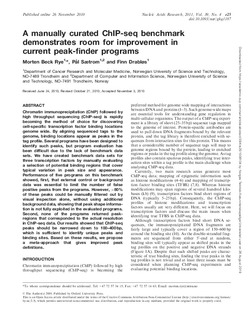| dc.contributor.author | Rye, Morten Beck | |
| dc.contributor.author | Sætrom, Pål | |
| dc.contributor.author | Drabløs, Finn | |
| dc.date.accessioned | 2019-08-27T10:50:07Z | |
| dc.date.available | 2019-08-27T10:50:07Z | |
| dc.date.created | 2011-01-04T08:32:53Z | |
| dc.date.issued | 2011 | |
| dc.identifier.citation | Nucleic Acids Research. 2011, 39 (4), . | nb_NO |
| dc.identifier.issn | 0305-1048 | |
| dc.identifier.uri | http://hdl.handle.net/11250/2611176 | |
| dc.description.abstract | Chromatin immunoprecipitation (ChIP) followed by high throughput sequencing (ChIP-seq) is rapidly becoming the method of choice for discovering cell-specific transcription factor binding locations genome wide. By aligning sequenced tags to the genome, binding locations appear as peaks in the tag profile. Several programs have been designed to identify such peaks, but program evaluation has been difficult due to the lack of benchmark data sets. We have created benchmark data sets for three transcription factors by manually evaluating a selection of potential binding regions that cover typical variation in peak size and appearance. Performance of five programs on this benchmark showed, first, that external control or background data was essential to limit the number of false positive peaks from the programs. However, >80% of these peaks could be manually filtered out by visual inspection alone, without using additional background data, showing that peak shape information is not fully exploited in the evaluated programs. Second, none of the programs returned peak-regions that corresponded to the actual resolution in ChIP-seq data. Our results showed that ChIP-seq peaks should be narrowed down to 100–400 bp, which is sufficient to identify unique peaks and binding sites. Based on these results, we propose a meta-approach that gives improved peak definitions. | nb_NO |
| dc.language.iso | eng | nb_NO |
| dc.publisher | Oxford University Press | nb_NO |
| dc.relation.uri | http://nar.oxfordjournals.org/content/early/2010/11/25/nar.gkq1187.long | |
| dc.rights | Navngivelse-Ikkekommersiell 4.0 Internasjonal | * |
| dc.rights.uri | http://creativecommons.org/licenses/by-nc/4.0/deed.no | * |
| dc.title | A manually curated ChIP-seq benchmark demonstrates room for improvement in current peak-finder programs | nb_NO |
| dc.type | Journal article | nb_NO |
| dc.type | Peer reviewed | nb_NO |
| dc.description.version | publishedVersion | nb_NO |
| dc.source.pagenumber | 11 | nb_NO |
| dc.source.volume | 39 | nb_NO |
| dc.source.journal | Nucleic Acids Research | nb_NO |
| dc.source.issue | 4 | nb_NO |
| dc.identifier.doi | 10.1093/nar/gkq1187 | |
| dc.identifier.cristin | 517100 | |
| dc.description.localcode | The Author(s) 2010. Published by Oxford University Press. This is an Open Access article distributed under the terms of the Creative Commons Attribution Non-Commercial License (http://creativecommons.org/licenses/ by-nc/2.5), which permits unrestricted non-commercial use, distribution, and reproduction in any medium, provided the original work is properly cited. | nb_NO |
| cristin.unitcode | 194,65,15,0 | |
| cristin.unitcode | 194,63,10,0 | |
| cristin.unitname | Institutt for klinisk og molekylær medisin | |
| cristin.unitname | Institutt for datateknologi og informatikk | |
| cristin.ispublished | true | |
| cristin.fulltext | original | |
| cristin.qualitycode | 2 | |

